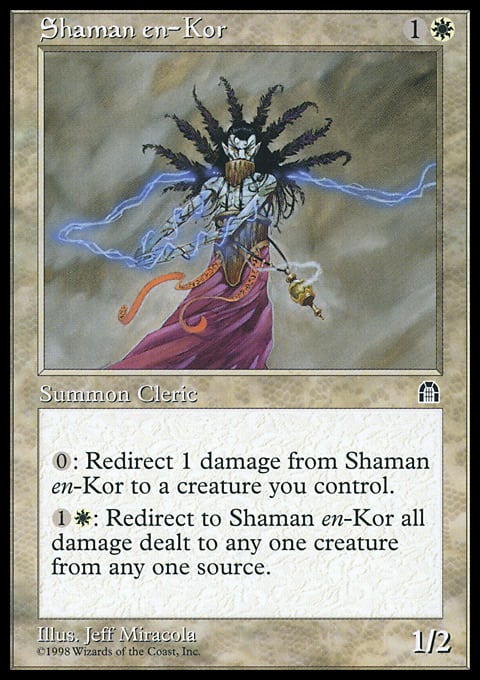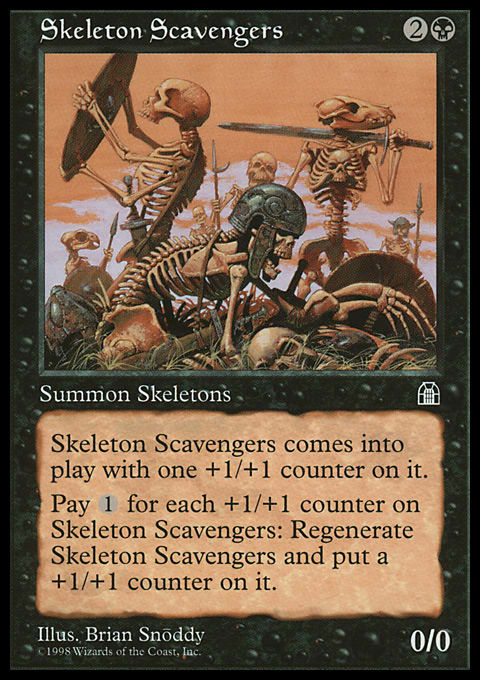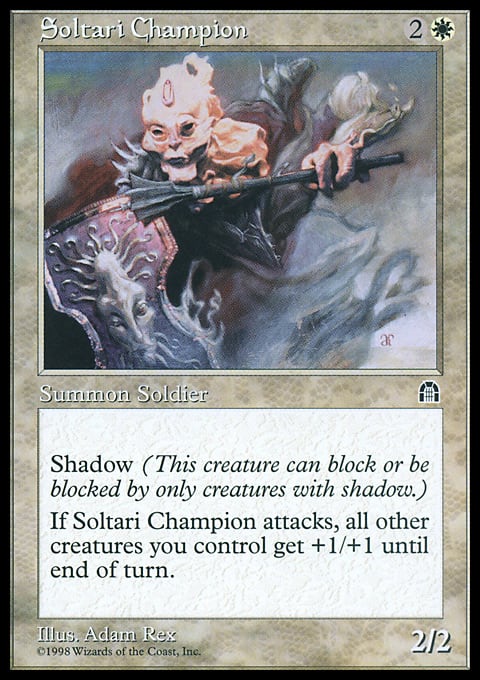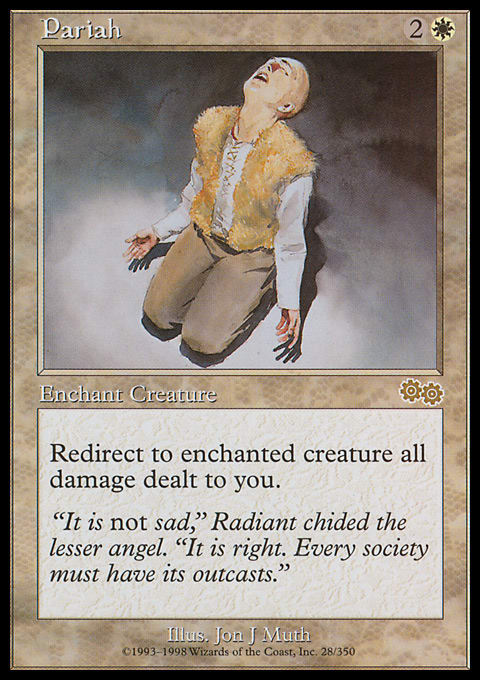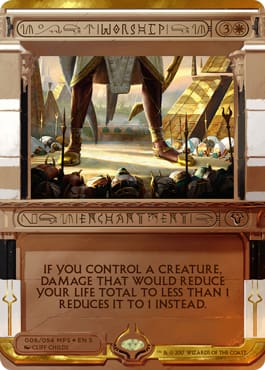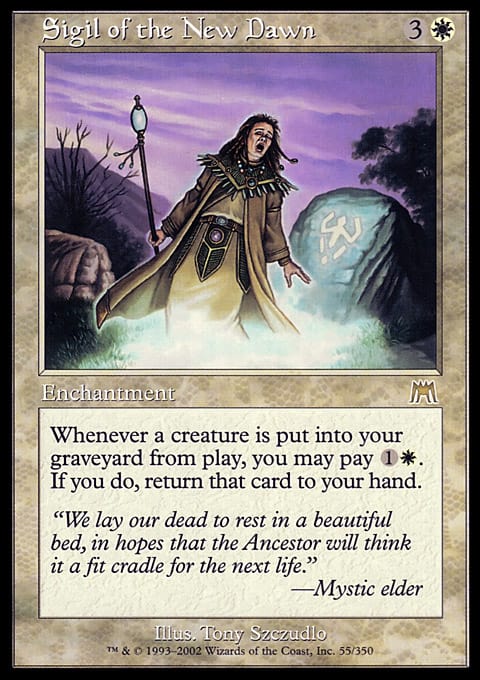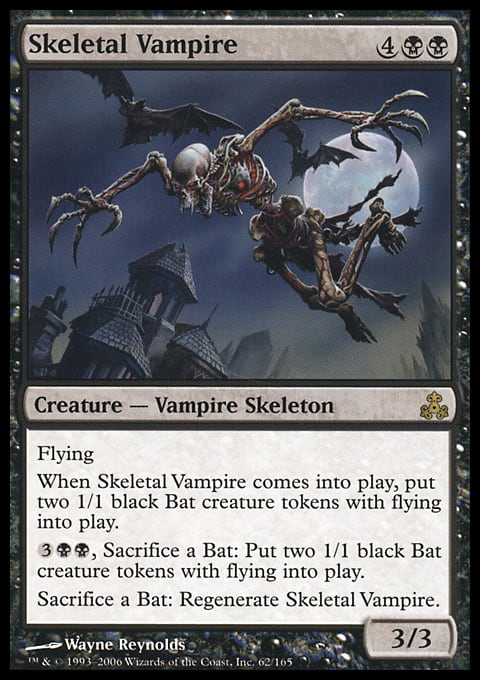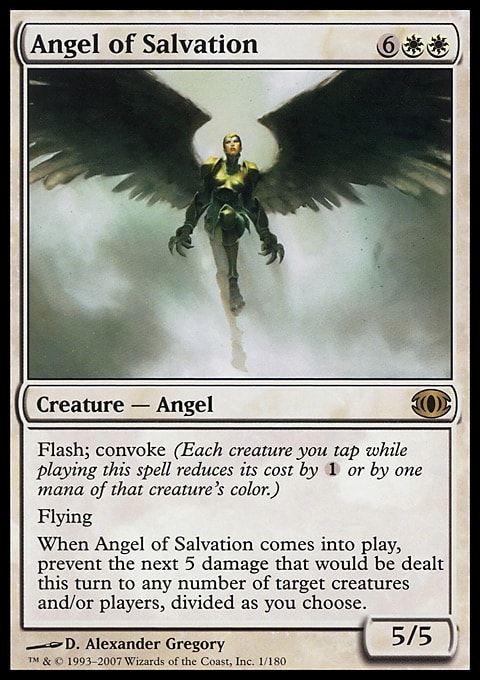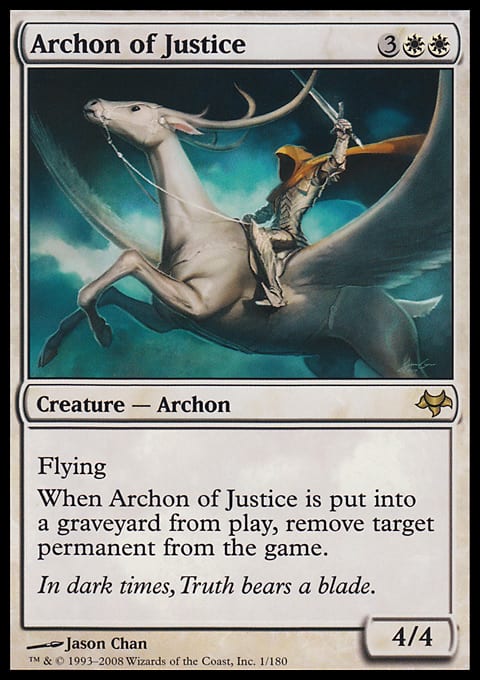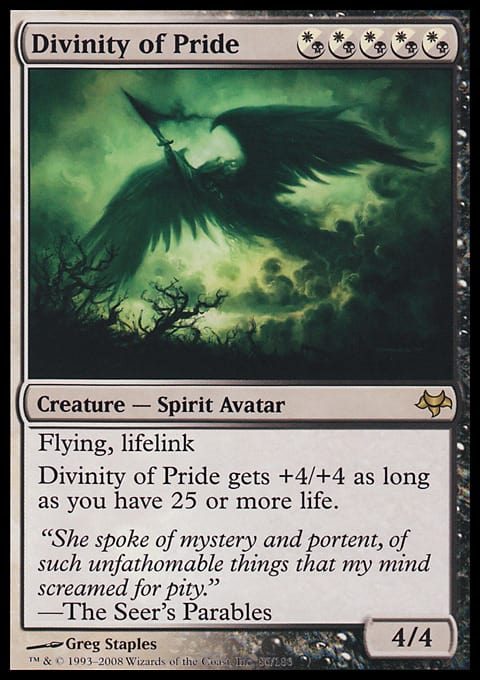A few weeks ago we took a tour of the Theme Decks of the Izzet archetype (U/R), and one of our readers asked if we might take the Orzhov on the same journey. Unlike the Izzet, who gradually found their way to a “spells matter” theme over the course of their Preconstructed life, the Orzhov’s journey — as we’ll see — is considerably less linear. But it does cover some interesting ground, including some tribal decks, some decks that explore the dichotomy of the guild’s two composite colors . . . and one of the most notable Preconstructed decks ever created by Wizards of the Coast.
Let’s jump in the time machine, and off we go!
Year: 1998
Set: Stronghold
Deck: Call of the Kor
Rares: Shaman en-Kor, Skeleton Scavengers, Soltari Champion
Call of the Kor ? Theme Deck | Wizards of the Coast
- Creatures (21)
- 1 Cloudchaser Eagle
- 1 Darkling Stalker
- 1 Screeching Harpy
- 1 Shaman en-Kor
- 1 Skeleton Scavengers
- 1 Soltari Champion
- 2 Gravedigger
- 2 Knight of Dawn
- 2 Lancers en-Kor
- 2 Warrior en-Kor
- 3 Nomads en-Kor
- 4 Spirit en-Kor
- Instants (4)
- 1 Dark Banishing
- 1 Disenchant
- 1 Smite
- 1 Temper
- Sorceries (5)
- 1 Death Stroke
- 2 Evincar's Justice
- 2 Lab Rats
- Enchantments (6)
- 1 Flickering Ward
- 2 Enfeeblement
- 3 Endless Scream
Who knew that our traipse through Magic’s history would begin on so modern a note? While the Kor race had its in-game debut on the plane of Rath for Tempest Block, they are now much more commonly associated with their (apparently ret-conned) homeworld of Zendikar. While in both iterations the Kor are associated with nomadism, mechanically they play out rather differently.
While the Zendikari Kor get abilities like tapping down opponents (Kor Line-Slinger, Kor Entanglers) and flying (Kor Aeronaut, Kor Skyfisher), thematically associated through their affinity for ropes, harnesses, and high places, the Rathi Kor had a unique damage-redirection ability meant to be an updated take on banding.
Call of the Kor showcases this damage-redirection, a nettlesome ability given its lack of an activation cost. While largely consisting of weenie-sized creatures (the single largest beater is a 3/3), you nevertheless could extend the life of your troops by spreading any damage around. Since it’s free to do, you’ve got fertile ground for shenanigans, such as sending all damage to the Skeleton Scavengers or Knight of Dawn, or equipping the Shaman en-Kor with Flickering Ward. Or even the truly silly, like redirecting a ton of damage to the Soltari Champion, and using Temper to make the hard-to-block shadow creature attain grotesque proportions.
Black was mainly a wingman here, offering some removal and a trio of Endless Screams, so there wasn’t a lot of synergy, but thanks to the Kor’s unique (and discontinued) ability, this could prove a frustrating deck to be up against.
Year: 1998
Set: Urza’s Saga
Deck: The Plague
The Plague ? Theme Deck | Wizards of the Coast
- Creatures (16)
- 1 Blood Vassal
- 1 Flesh Reaver
- 1 Sanctum Guardian
- 1 Silent Attendant
- 3 Disciple of Grace
- 3 Unworthy Dead
- 3 Voice of Grace
- 3 Wall of Junk
- Instants (6)
- 2 Disenchant
- 2 Expunge
- 2 Humble
- Enchantments (10)
- 1 Opal Acrolith
- 1 Pariah
- 1 Sicken
- 1 Worship
- 2 Rune of Protection: Black
- 4 Pestilence
- Artifacts (2)
- 2 Urza's Armor
- Lands (24)
- 12 Swamp
- 7 Plains
- 2 Polluted Mire
- 3 Drifting Meadow
Urza’s Saga famously made a lot of mistakes, being the lead set in a block rightly considered by most to be the most broken in the history of the game. Lots of ink has covered the Constructed missteps, but Head Designer Mark Rosewater has also taken pains in his Drive to Work podcast to cover some of the issues with the Limited environment of the set as well. Top of the list? Pestilence as a common.
It’s not often you see a Preconstructed deck almost entirely built around a single card, but The Plague made no bones about what it was made to do: keep the board clear of creatures through a playset of the powerful Black enchantment. Predictably, the deck was packed full of ways to break the symmetry of the card, ensuring that the brunt of the pain would be felt by your opponent, not you.
Creatures with protection from Black, like the Disciple of Grace and Voice of Grace, not only ensured that you’d have attackers each turn after using Pestilence, but also ensured that your enchantment wouldn’t have to be sacrificed due to a carrier-free zone. Silent Attendant offered a steady drip of lifegain to help cushion the Pestilence damage, while Rune of Protection: Black offered some additional sanctuary. And if you enchanted one of your protection creatures with Pariah, it was all Alfred E. Neumann from there.
When we looked at the history of the Preconstructed U/R decks, it was interesting to note which ones were simply U/R versions of conventional decks (turn dudes sideways, support with spells). The ones that really stood out were the ones that brought something unique to the table, and The Plague is undoubtedly one of the most unique and noteworthy decks in Magic’s long Preconstructed history.
Feel free to substitute “filthy” instead.
Year: 2000
Set: Prophecy
Deck: Distress
Rares: Avatar of Woe, Rhystic Tutor
Distress ? Theme Deck| Wizards of the Coast
- Creatures (19)
- 1 Agent of Shauku
- 1 Avatar of Woe
- 1 Ballista Squad
- 1 Belbe's Percher
- 1 Chilling Apparition
- 1 Death Charmer
- 1 Nakaya Shade
- 1 Plague Fiend
- 1 Shield Dancer
- 1 Spineless Thug
- 2 Fresh Volunteers
- 2 Glittering Lynx
- 2 Skulking Fugitive
- 3 Glittering Lion
- Instants (9)
- 1 Afterlife
- 1 Angelic Favor
- 1 Disenchant
- 1 Snuff Out
- 1 Steal Strength
- 2 Dark Ritual
- 2 Excise
- Sorceries (8)
- 1 Rhystic Tutor
- 2 Rain of Tears
- 2 Rhystic Syphon
- 3 Despoil
- Enchantments (3)
- 1 Maggot Therapy
- 1 Seal of Cleansing
- 1 Seal of Doom
In April of this year, a reader wrote in to Mark Rosewater on his Blogatog blog, asking about the “Rhystic mechanic” featured in the Prophecy set. “Very poorly,” came the answer. Most Magic cards tend to focus on giving their caster a range of options, but Rhystic cards put some of the ultimate fate of the spell in the hands of an opponent.
While this had the effect of either depleting an opponent’s mana (as they disabled triggered Rhystic effects), or punishing them for tapping out (since they could no longer pay to disable triggered Rhystic effects), many players balked at ceding control over their actions to their opponent. And Distress was packed with it.
For instance, the Nakaya Shade gave your opponent the chance to ‘counter’ your pump, while the Plague Fiend effectively has deathtouch that your opponent can pay to turn off for the turn. Spells like Rhystic Syphon and Rhystic Tutor, could be dismissed entirely if your opponent chose to pay the “Rhystic tax.”
All of this adds up to some very fiddly gameplay, where you have to play around your opponent’s open mana each turn when deciding how to attack and what to cast. The only other feature of note here is the interesting inclusion of a land destruction subtheme (Despoil, Rain of Tears), but all in all this deck suffers the same fate as its central mechanic.
Year: 2002
Set: Torment
Deck: Sacrilege
Rares: Angel of Retribution, Ichorid
Sacrilege ? Theme Deck| Wizards of the Coast
- Creatures (25)
- 1 Angel of Retribution
- 1 Auramancer
- 1 Aven Cloudchaser
- 1 Carrion Wurm
- 1 Crypt Creeper
- 1 Grotesque Hybrid
- 1 Ichorid
- 1 Stern Judge
- 1 Teroh's Vanguard
- 1 Whispering Shade
- 2 Cabal Surgeon
- 3 Mystic Familiar
- 3 Putrid Imp
- 3 Teroh's Faithful
- 4 Gravedigger
- Sorceries (8)
- 1 Zombify
- 3 Buried Alive
- 4 Crippling Fatigue
- Enchantments (3)
- 1 Hypochondria
- 1 Malevolent Awakening
- 1 Strength of Isolation
- Lands (24)
- 10 Plains
- 12 Swamp
- 2 Tainted Field
B/W decks took a break for nearly two years following Distress, but unsurprisingly returned in 2002’s Torment. This was a set that played with color distribution, being skewed more heavily toward Black at the expense of the other colors (something Wizards would not repeat). Each of the four Theme Decks for Torment incorporated Black alongside one of the other colors, and Sacrilege was the White pairing.
This gave Sacrilege the ability to gleefully play anti-Black options, knowing in that that environment, the chances of them bearing fruit were quite high. That direction was reflected in cards like Whispering Shade, Strength of Isolation, and Stern Judge. But the bread and butter of the deck was graveyard machinations, as Torment was the second set in Odyssey block.
Using Putrid Imps, Buried Alive, and Hypochondria, players could fill up their graveyard, then use it to power all sorts of options. The deck carried a number of threshold cards, from Mystic Familiar to Teroh's Vanguard, which rewarded you for keeping a well-stocked pantry. Meanwhile, you could use the graveyard to fuel an Ichorid pounding in turn after turn, or Gravediggers and an Auramancer to pull something back into your hand.
Sacrilege wasn’t the flashiest deck, but it stuck to its themes and did at least a passable job at pulling them all together.
Year: 2002
Set: Onslaught
Deck: Ivory Doom
Rares: Gangrenous Goliath, Sigil of the New Dawn
Ivory Doom ? Theme Deck | Wizards of the Coast
- Creatures (23)
- 1 Aven Soulgazer
- 1 Cabal Executioner
- 1 Daunting Defender
- 1 Gangrenous Goliath
- 1 Headhunter
- 2 Battlefield Medic
- 2 Cabal Archon
- 2 Disciple of Grace
- 2 Doubtless One
- 3 Daru Healer
- 3 Foothill Guide
- 4 Disciple of Malice
- Instants (6)
- 1 Akroma's Blessing
- 1 Death Pulse
- 2 Smother
- 2 Swat
- Sorceries (2)
- 2 Profane Prayers
- Enchantments (4)
- 1 Astral Slide
- 1 Sigil of the New Dawn
- 2 Pacifism
- Lands (25)
- 8 Plains
- 8 Swamp
- 1 Starlit Sanctum
- 4 Barren Moor
- 4 Secluded Steppe
B/W got its second tribal deck in 2002’s tribally-themed set, Onslaught. Just as with the Kor, Ivory Doom centers itself around something that’s off the beaten path, using Clerics to build the deck around. No one Cleric pulls the deck together so much as attaining a critical mass of them, which allows you to do two things. First, it powers up cards like Doubtless One and Battlefield Medic, which get stronger with every Cleric you play.
Second, the deck looked to get control of the battlefield through lifegain and damage prevention, letting you then turn your attention to whittling down your opponent. The Cabal Archon was itself a win condition here, since you could use its effect more than once per turn and drain out your opponent while pounding in the red zone with a Gangrenous Goliath. There were a couple of morph options included as well to keep your opponent off-balance (Headhunter, Foothill Guide), keeping the set tied to its block, but overall this was a fairly self-contained construction.
It was also the last time we’d see another B/W deck for over three years. The Izzet decks provided an interesting study in contrasts, from the “how does U/R do it” (conventional deck) to “let’s see what U/R can do” (things only possible in those colors). Sadly, the Orzhov reality to this point was considerably less impressive. We had a couple of tribal decks in the Call of the Kor and Ivory Doom. There were a couple decks that played to their set’s themes, to effects both poor (the Rhystic Distress) and positive (Torment’s Black-and-graveyard-themed Sacrilege). The pick of the litter, The Plague, was itself an unusual deck built around a single card. None of these, however, gave any identity to the overall color pairing of B/W as we conceive it today.
Two years later, that began to change.
Year: 2006
Set: Guildpact
Deck: Code of the Orzhov
Rares: Skeletal Vampire, Teysa, Orzhov Scion
Code of the Orzhov ? Theme Deck | Wizards of the Coast
- Creatures (26)
- 1 Belfry Spirit
- 1 Martyred Rusalka
- 1 Orzhov Guildmage
- 1 Plagued Rusalka
- 1 Skeletal Vampire
- 1 Teysa, Orzhov Scion
- 2 Agent of Masks
- 2 Blind Hunter
- 2 Infectious Host
- 2 Mourning Thrull
- 2 Orzhov Euthanist
- 2 Ostiary Thrull
- 2 Poisonbelly Ogre
- 2 Shrieking Grotesque
- 2 Souls of the Faultless
- 2 Thoughtpicker Witch
- Instants (2)
- 1 Festival of the Guildpact
- 1 Mortify
- Sorceries (2)
- 2 Castigate
- Enchantments (6)
- 2 Hissing Miasma
- 2 Pillory of the Sleepless
- 2 Strands of Undeath
- Lands (24)
- 10 Plains
- 11 Swamp
- 1 Orzhova, the Church of Deals
- 2 Orzhov Basilica
As with the majority of color pairs, the modern-day definition of B/W finds its origin in Ravnica. Guildpact’s Code of the Orzhovgave the color combination a name, but — more importantly — an identity to go with it. Black and White wasn’t just two colors jammed together, but were colors that had an identifiable overlap and synergy.
Code of the Orzhov reinforced this in two ways, one which was a success, the other a failure. The failure was the haunt mechanic. “Of all the mechanics in the original Ravnica block,” wrote Mark Rosewater, “this one was the greatest disappointment to me . . . It seemed like it should have been awesome, but it ended up being miserable to play.” I’ll never forget breaking out Code of the Orzhov for the first time, and having to go search the internet to figure out exactly how to play haunt. It was clunky and unintuitive, and played in the same ambiguous space as the much later cipher. Unsurprisingly, both mechanics, which involve “attaching” cards to one another, rated a 9 on Rosewater’s “Storm Scale,” meaning it would require a minor miracle to ever see them return.
What worked? The bleeder mechanic. This was hardly new to the game of Magic, though bleeding had last seen its heyday at the very dawn of the game, when you’d see it represented across a variety of colors in cards like Wanderlust, Psychic Venom, and Cursed Land. Guildpact wove it into the guild’s identity, through cards like Pillory of the Sleepless, Hissing Miasma, and Agent of Masks.
The deck itself wasn’t all that spectacular, but the effect it had on the future of B/W mechanics was undeniable. There’s a clear line of progression between the vision of the Orzhov represented here (ignoring haunt), and the extort mechanic in the Orzhov’s second iteration, Gatecrash. This wasn’t the Orzhov Made Perfect, but it was certainly the Seed of Things to Come.
Year: 2007
Set: Future Sight
Deck: Rebels Unite
Rares: Angel of Salvation, Magus of the Abyss
Rebels Unite ? Theme Deck| Wizards of the Coast
- Creatures (26)
- 1 Amrou Scout
- 1 Angel of Salvation
- 1 Aven Riftwatcher
- 1 Big Game Hunter
- 1 Blightspeaker
- 1 Defiant Vanguard
- 1 Knight of the Holy Nimbus
- 1 Magus of the Abyss
- 1 Riftmarked Knight
- 1 Zealot il-Vec
- 2 Errant Doomsayers
- 2 Outrider en-Kor
- 2 Putrid Cyclops
- 2 Ramosian Revivalist
- 2 Samite Censer-Bearer
- 3 Amrou Seekers
- 3 Blade of the Sixth Pride
- Instants (4)
- 2 Dawn Charm
- 2 Return to Dust
- Enchantments (6)
- 1 Witch's Mist
- 3 Lumithread Field
- 2 Bound in Silence
- Lands (24)
- 10 Swamp
- 12 Plains
- 2 Terramorphic Expanse
Time Spiral was the block that played with time, largely dealing with callbacks to the past of Magic. These callbacks weren’t always rearward-facing, as in the case with the history-referencing Time Spiral. They could also be lateral shifts of Magic’s timeline, as with Planar Chaos, or represent future potentialities as with Future Sight.
Fitting, then, that we find our next tribal offering here, with the Rebels. The Rebels were a tribe introduced in Mercadian Masques, alongside their opposite number, the Mercenaries. Unlike most tribal classifications, their tribal designation centered not on a race or class, but on their particular philosophical outlook. This perhaps made some sense in the world of Mercadian Masques, but seemed a bit ridiculous and arbitrary in the Time Spiral setting. Cards like Samite Censer-Bearer and Blade of the Sixth Pride . . . what were they rebelling against?
(And no, unlike the Wild Ones, “whaddaya got” is not a satisfactory answer here.)
As to be expected, this is a heavily creature-centric deck using the Rebel mechanic (creatures that tutor up other Rebels based on mana cost), and boasted an impressive twenty-six creatures. Future Sight even included a “Rebel Aura” Tribal Enchantment in the form of Bound in Silence. This is my Vorthos showing, but what about that card made it Rebel?
If you can get past how clumsily arbitrary the whole thing felt, as exemplified by Big Game Hunter being a “Human Rebel Assassin,” it wasn’t a bad deck. But like a number of the others, it didn’t “feel” particularly Black and White. Which brings us to our final Theme Deck . . .
Year: 2008
Set: Eventide
Deck: Life Drain
Rares: Archon of Justice, Divinity of Pride
Life Drain ? Theme Deck| Wizards of the Coast
- Creatures (24)
- 1 Archon of Justice
- 1 Divinity of Pride
- 1 Flickerwisp
- 1 Goldenglow Moth
- 1 Resplendent Mentor
- 1 Restless Apparition
- 1 Soul Snuffers
- 1 Suture Spirit
- 1 Woeleecher
- 2 Apothecary Initiate
- 2 Gwyllion Hedge-Mage
- 2 Kithkin Zealot
- 2 Safehold Sentry
- 2 Smolder Initiate
- 2 Voracious Hatchling
- 3 Nip Gwyllion
- Instants (5)
- 1 Batwing Brume
- 1 Beckon Apparition
- 1 Endure
- 2 Unmake
- Sorceries (5)
- 1 Rite of Consumption
- 2 Soul Reap
- 2 Syphon Life
- Enchantments (2)
- 2 Recumbent Bliss
One could scarcely ask for a more fitting deck to end on for B/W than Eventide’s Life Drain. With the bleeder shenanigans of Code of the Orzhov still in our rearview mirror, here was a deck that turned the bleeder mechanic on its head. What if, instead of focusing on life loss, we focused instead on life gain?
Sure, the payoff is somewhat modest, with the only tangible benefit (besides a swollen life total) being the activation of the Divinity of Pride. But the deck also plays up a life draining subtheme, which sees you diminish your opponent’s life total as you pad your own.
As for creatures, the deck had some teeth behind the aforementioned Divinity of Pride, as well as cards like Archon of Justice, Voracious Hatchling, and Restless Apparition. While no The Plague, it’s commendable to see another deck so fiercely staking out some rather unconventional territory in the overlap between White and Black.
With this, the Theme Deck era came to an end, as the Intro Packs rose up to take their place. And while Black and White’s interplay would change take on a new form with in the Intro Pack era, it would mark a welcome break from the somewhat scattershot approach the color pairing enduring in the Theme Deck era.
But we’ll always have The Plague.
On a final note, I included deck lists this time around for all decks covered, which I did not do for our Izzet piece. Let me know if the comments below if you find this preferable, or prefer the cleaner version without decklists. Thanks!













